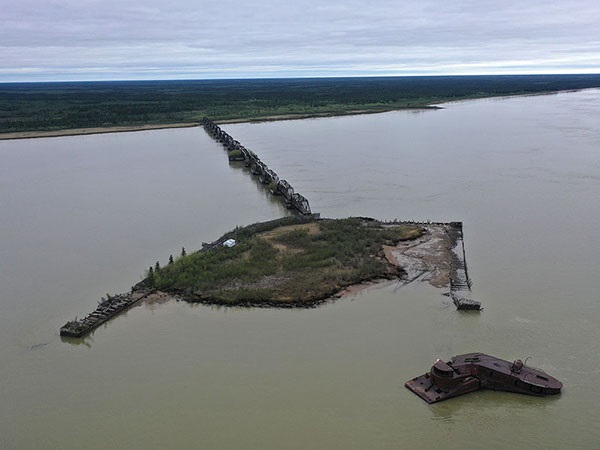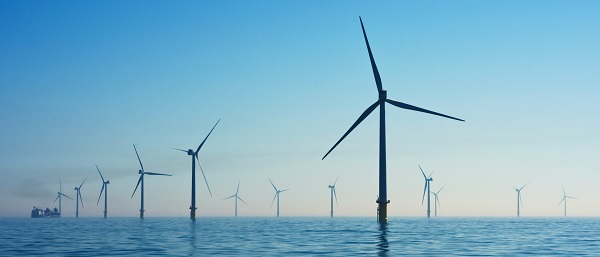Alberta
MB/SK/AB NeeStaNan Utilities Corridor: First Nations-led utility corridor is a 21st-century nation-building initiative

Port Nelson is 300 kilometres south of Churchill and has a longer ice-free season. In fact, a concrete jetty constructed (and never used) at Port Nelson nearly a hundred years ago remains in place.
From the Frontier Centre for Public Policy
By Terry Etam
“The trading of goods has been in our DNA as Indigenous People for centuries, but somewhere along the way this was lost. It’s time to regain our prosperity, for the betterment of our communities and for our country.” – NeeStaNan website
Ever feel like you’re being neglected by either governments or the various power centers that dominate life? The big places get all the attention, have all the votes, have all the buzz. In Canada, fewer than ten such centers dominate the country. If you’re not in one of those, you won’t know much political power, there won’t be much clout, there won’t be much of anything.
And if you want to know how far you can get from a circle of influence, consider Census Division No. 23, a great big administrative district in northern Manitoba. The size and ruggedness are mindboggling; No. 23 encompasses an area of 233,578 square km/90,185 square miles, six times the area of Switzerland, yet the region’s total population is 4,690. The population density, rounded to the nearest person-per-square km, is zero. If you round it to the nearest tenth of a square km, it is still zero.
It is extremely hard for people of regions like this to register on the national radar for any number of reasons, some of which are just logistical (remote location) and some of which are just rude realities (not much political capital up for grabs in No. 23).29dk2902l
The people of regions like this tend to be absent from all sorts of things, including resource development, even if it happens in these regions. Yes, there will be some local employment, and positive economic spinoffs, but nothing in the way of meaningful ownership or control.
But that may be about to change, for a significant swath of Manitoba, Saskatchewan, and the northeastern part of Alberta. Underway is the NeeStaNan utility corridor, stretching from northern Alberta through north-central Saskatchewan and on to the shores of Hudson Bay in Manitoba.
The significance of this corridor could be profound. It will provide tidewater access for landlocked western Canadian resources that otherwise need to travel to the west coast, or other less efficient routes. As one of the best examples, Saskatchewan must move potash to market via Vancouver, meaning a trip through the Rocky Mountains and on to the coast.
By utilizing the NeeStaNan utility corridor, potash will be able to move to large markets like Brazil far more efficiently. The distance to seawater via Hudson Bay is 630 km/390 miles less than by going through BC ports, and here’s the real economic kicker: the sea route to Brazil’s market is actually 3,800 km less than current routes. That’s almost 2,400 miles, for American friends and for old times’ sake.
The corridor is planned to enter Hudson Bay not at Churchill, but at a much more direct and accessible point called Port Nelson. Port Nelson is some 300 kilometres/180 miles south of Churchill (Hudson Bay is really freaking big) and has a longer ice-free season. In fact, a concrete jetty constructed (and never used) at Port Nelson nearly a hundred years ago remains in place. Port Nelson isn’t a new idea.
The utility corridor isn’t simply a project to enhance the wellbeing of the FN bands along the way, although it will most certainly do that. It is also far more grand in scope: the utility corridor will help Canada’s heartland deliver industrial products to global markets in a more efficient way, and provide the sort of efficiencies that can help multiple Canadian industries enhance global competitiveness, all the while providing an economic boost that is infinitely better than what locals and First Nations along the way have ever known.
Many industries could benefit, including the oil and gas sector, and I’m going to say that now before any legislation passes that makes it illegal. There is potential to utilize the corridor to move rail cargoes, pipelines, lumber, agricultural products, raw materials, manufactured goods… an endless array of the stuff that makes Canada wealthy.
The project is enormously captivating right from its very name. “NeeStaNan” translates as “all of us”. How cool is that; inclusiveness not under the guise some overwrought mandate, but in the sense that the project is being structured to benefit a great number of parties. The home page of the NeeStaNan website describes the project as a utility corridor “uniting Canadians”. Now, doesn’t that phrase sound far more powerful coming from the heartland, from people with skin in the game, as opposed to insincere platitudes thrown about like confetti on the campaign trail?
The utility corridor really could unite Canadians; it is a slingshot of vitality into Canada’s industrial base. It could benefit many critical industries, and open up new trade possibilities. It is a project designed to bring in many First Nations along the route that have very little to show for Canada’s development. It’s not a handout, it’s the opposite – a benefit to Canada and a great many Canadians.
Isn’t this what First Nations Self Determination should be about? Isn’t this a perfect dovetail with the interests of the people who live in these remote areas, who are the only ones there, and who deserve a say in how it is developed? Isn’t it amazing that it is a collaborative effort that by design will benefit industries that these First Nations have no direct stake in?
Isn’t it the best possible goal and achievement of all the efforts to bring First Nations fully into the Canadian matrix on a way that works for everyone, and that benefits everyone?
And who would be better than First Nations along the corridor’s path as the stewards of the corridor itself? Who knows the terrain better? I’ve been there, I grew up not in the path of the corridor but I could see it from a north facing window, and I’ll tell you it’s not territory for the faint of heart. Winters are brutal and long, summers are hot and buggy, and nature is relentless. Local expertise and wisdom would be invaluable.
I can’t really think of an infrastructure project of the past fifty years that could have such multi-dimensional benefits to so many Canadians. It is uplifting to see collaboration across many First Nations and the governments of three provinces. Ottawa may not like it, because the corridor is sure to empower an area of the country that has few votes to harvest, but that is all the more reason to get behind and support the project’s owners, organizers, and operators.
The NeeStaNan utility corridor might do more for a forgotten region of Canada, and its First Nations, than 150 years of federal government “help”. Let’s hope all three prairie provinces and the First Nations along the way bring the corridor into life and to its full potential.
Terry Etam is a columnist with the BOE Report, a leading energy industry newsletter based in Calgary. He is the author of The End of Fossil Fuel Insanity. You can watch his Policy on the Frontier session from May 5, 2022 here.
Alberta
Alberta Next Panel calls for less Ottawa—and it could pay off

From the Fraser Institute
By Tegan Hill
Last Friday, less than a week before Christmas, the Smith government quietly released the final report from its Alberta Next Panel, which assessed Alberta’s role in Canada. Among other things, the panel recommends that the federal government transfer some of its tax revenue to provincial governments so they can assume more control over the delivery of provincial services. Based on Canada’s experience in the 1990s, this plan could deliver real benefits for Albertans and all Canadians.
Federations such as Canada typically work best when governments stick to their constitutional lanes. Indeed, one of the benefits of being a federalist country is that different levels of government assume responsibility for programs they’re best suited to deliver. For example, it’s logical that the federal government handle national defence, while provincial governments are typically best positioned to understand and address the unique health-care and education needs of their citizens.
But there’s currently a mismatch between the share of taxes the provinces collect and the cost of delivering provincial responsibilities (e.g. health care, education, childcare, and social services). As such, Ottawa uses transfers—including the Canada Health Transfer (CHT)—to financially support the provinces in their areas of responsibility. But these funds come with conditions.
Consider health care. To receive CHT payments from Ottawa, provinces must abide by the Canada Health Act, which effectively prevents the provinces from experimenting with new ways of delivering and financing health care—including policies that are successful in other universal health-care countries. Given Canada’s health-care system is one of the developed world’s most expensive universal systems, yet Canadians face some of the longest wait times for physicians and worst access to medical technology (e.g. MRIs) and hospital beds, these restrictions limit badly needed innovation and hurt patients.
To give the provinces more flexibility, the Alberta Next Panel suggests the federal government shift tax points (and transfer GST) to the provinces to better align provincial revenues with provincial responsibilities while eliminating “strings” attached to such federal transfers. In other words, Ottawa would transfer a portion of its tax revenues from the federal income tax and federal sales tax to the provincial government so they have funds to experiment with what works best for their citizens, without conditions on how that money can be used.
According to the Alberta Next Panel poll, at least in Alberta, a majority of citizens support this type of provincial autonomy in delivering provincial programs—and again, it’s paid off before.
In the 1990s, amid a fiscal crisis (greater in scale, but not dissimilar to the one Ottawa faces today), the federal government reduced welfare and social assistance transfers to the provinces while simultaneously removing most of the “strings” attached to these dollars. These reforms allowed the provinces to introduce work incentives, for example, which would have previously triggered a reduction in federal transfers. The change to federal transfers sparked a wave of reforms as the provinces experimented with new ways to improve their welfare programs, and ultimately led to significant innovation that reduced welfare dependency from a high of 3.1 million in 1994 to a low of 1.6 million in 2008, while also reducing government spending on social assistance.
The Smith government’s Alberta Next Panel wants the federal government to transfer some of its tax revenues to the provinces and reduce restrictions on provincial program delivery. As Canada’s experience in the 1990s shows, this could spur real innovation that ultimately improves services for Albertans and all Canadians.
Alberta
Ottawa-Alberta agreement may produce oligopoly in the oilsands

From the Fraser Institute
By Jason Clemens and Elmira Aliakbari
The federal and Alberta governments recently jointly released the details of a memorandum of understanding (MOU), which lays the groundwork for potentially significant energy infrastructure including an oil pipeline from Alberta to the west coast that would provide access to Asia and other international markets. While an improvement on the status quo, the MOU’s ambiguity risks creating an oligopoly.
An oligopoly is basically a monopoly but with multiple firms instead of a single firm. It’s a market with limited competition where a few firms dominate the entire market, and it’s something economists and policymakers worry about because it results in higher prices, less innovation, lower investment and/or less quality. Indeed, the federal government has an entire agency charged with worrying about limits to competition.
There are a number of aspects of the MOU where it’s not sufficiently clear what Ottawa and Alberta are agreeing to, so it’s easy to envision a situation where a few large firms come to dominate the oilsands.
Consider the clear connection in the MOU between the development and progress of Pathways, which is a large-scale carbon capture project, and the development of a bitumen pipeline to the west coast. The MOU explicitly links increased production of both oil and gas (“while simultaneously reaching carbon neutrality”) with projects such as Pathways. Currently, Pathways involves five of Canada’s largest oilsands producers: Canadian Natural, Cenovus, ConocoPhillips Canada, Imperial and Suncor.
What’s not clear is whether only these firms, or perhaps companies linked with Pathways in the future, will have access to the new pipeline. Similarly, only the firms with access to the new west coast pipeline would have access to the new proposed deep-water port, allowing access to Asian markets and likely higher prices for exports. Ottawa went so far as to open the door to “appropriate adjustment(s)” to the oil tanker ban (C-48), which prevents oil tankers from docking at Canadian ports on the west coast.
One of the many challenges with an oligopoly is that it prevents new entrants and entrepreneurs from challenging the existing firms with new technologies, new approaches and new techniques. This entrepreneurial process, rooted in innovation, is at the core of our economic growth and progress over time. The MOU, though not designed to do this, could prevent such startups from challenging the existing big players because they could face a litany of restrictive anti-development regulations introduced during the Trudeau era that have not been reformed or changed since the new Carney government took office.
And this is not to criticize or blame the companies involved in Pathways. They’re acting in the interests of their customers, staff, investors and local communities by finding a way to expand their production and sales. The fault lies with governments that were not sufficiently clear in the MOU on issues such as access to the new pipeline.
And it’s also worth noting that all of this is predicated on an assumption that Alberta can achieve the many conditions included in the MOU, some of which are fairly difficult. Indeed, the nature of the MOU’s conditions has already led some to suggest that it’s window dressing for the federal government to avoid outright denying a west coast pipeline and instead shift the blame for failure to the Smith government.
Assuming Alberta can clear the MOU’s various hurdles and achieve the development of a west coast pipeline, it will certainly benefit the province and the country more broadly to diversify the export markets for one of our most important export products. However, the agreement is far from ideal and could impose much larger-than-needed costs on the economy if it leads to an oligopoly. At the very least we should be aware of these risks as we progress.

Elmira Aliakbari
-

 Energy2 days ago
Energy2 days agoThe Top News Stories That Shaped Canadian Energy in 2025 and Will Continue to Shape Canadian Energy in 2026
-

 Frontier Centre for Public Policy23 hours ago
Frontier Centre for Public Policy23 hours agoTent Cities Were Rare Five Years Ago. Now They’re Everywhere
-

 International2 days ago
International2 days ago$2.6 million raised for man who wrestled shotgun from Bondi Beach terrorist
-

 Alberta2 days ago
Alberta2 days agoOttawa-Alberta agreement may produce oligopoly in the oilsands
-

 Fraser Institute8 hours ago
Fraser Institute8 hours agoCarney government sowing seeds for corruption in Ottawa
-

 International7 hours ago
International7 hours agoNo peace on earth for ISIS: Trump orders Christmas strikes after Christian massacres
-

 Daily Caller7 hours ago
Daily Caller7 hours agoUS Halts Construction of Five Offshore Wind Projects Due To National Security
-

 Opinion24 hours ago
Opinion24 hours agoPope Leo XIV’s Christmas night homily





